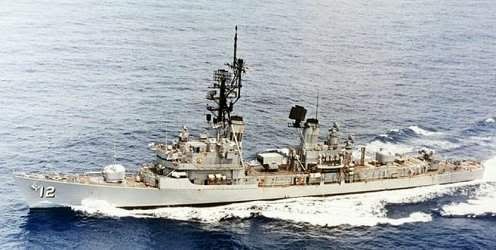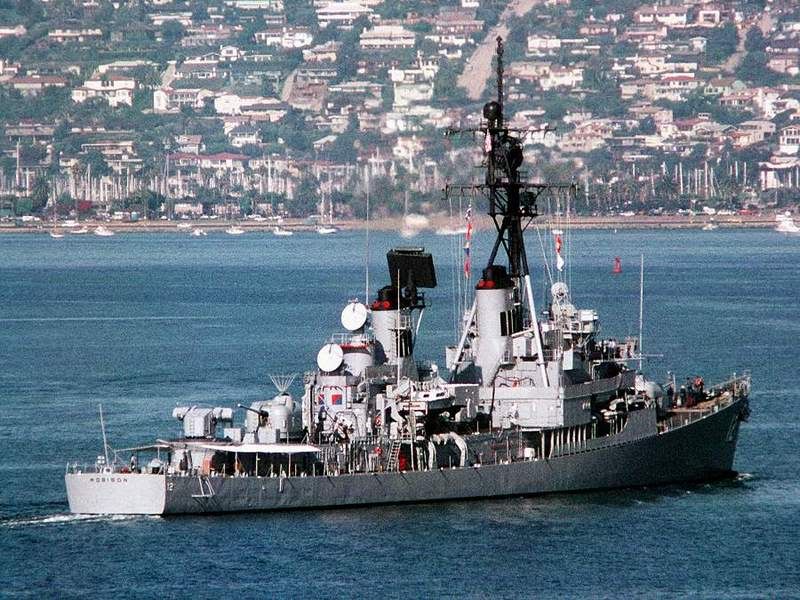To: DogByte6RER
Beaufiful ship.
I have a stupid question: what is it in the mission or size that determines the designation 'frigate' -v- 'destroyer' -v- 'cruiser'?
I asked because I noticed that Arleigh Burkes displace 9200 tons and are around 508 ft in length, almost the same as light cruisers during WW II. Ticonderoga-class cruisers looks similar to Arleigh Burke-class destroyers, in shape and size as well. What differentiates them?

USS Antiedam

USS Barry
To: struwwelpeter
I was a Navy destroyer sailor in the 1980s and what I can tell you about my ship is that it had two screws (propellers) driven by two 1200 psi steam driven turbine engines.
The frigates that I saw in the 80s were single screw ships. Frigate were a bit smaller than destroyers, but like destroyers they are highly maneuverable on the ocean. Many of the frigates as well had a helo deck with a helicopter as well.
My ship, a Charles Adams Class guided missile destroyer, was capable of performing anti-sub operations (through our sonar and ASROCs) as well as anti-aircraft tracking and such with our twin harpoon missile launcher.
Here...I'll attach a photo or two of my ship, the USS Robison DDG-12.
BTW...cruisers are much larger ships and while I was never on one, I understand that a cruiser will typically serve as the "eyes and ears" of a fleet battle group through the use of its AEGIS system. If other ships in the battle group also have AEGIS (like the newer destroyers) the cruisers will typically lead the other AEGIS capable ships and serve as point or the clearinghouse for all incoming tactical info.


91 posted on
12/04/2006 3:09:40 PM PST by
DogByte6RER
("Loose lips sink ships")
To: struwwelpeter
I was a Navy destroyer sailor in the 1980s and what I can tell you about my ship is that it had two screws (propellers) driven by two 1200 psi steam driven turbine engines.
The frigates that I saw in the 80s were single screw ships. Frigate were a bit smaller than destroyers, but like destroyers they are highly maneuverable on the ocean. Many of the frigates as well had a helo deck with a helicopter as well.
My ship, a Charles Adams Class guided missile destroyer, was capable of performing anti-sub operations (through our sonar and ASROCs) as well as anti-aircraft tracking and such with our twin harpoon missile launcher.
Here...I'll attach a photo or two of my ship, the USS Robison DDG-12.
BTW...cruisers are much larger ships and while I was never on one, I understand that a cruiser will typically serve as the "eyes and ears" of a fleet battle group through the use of its AEGIS system. If other ships in the battle group also have AEGIS (like the newer destroyers) the cruisers will typically lead the other AEGIS capable ships and serve as point or the clearinghouse for all incoming tactical info.


94 posted on
12/04/2006 3:11:15 PM PST by
DogByte6RER
("Loose lips sink ships")
To: struwwelpeter
I asked because I noticed that Arleigh Burkes displace 9200 tons and are around 508 ft in length, almost the same as light cruisers during WW II. Ticonderoga-class cruisers looks similar to Arleigh Burke-class destroyers, in shape and size as well. What differentiates them?
The designations have been messed up since the 1960s or so. What we currently call a "frigate" was originally typed as a "destroyer escort" (basically a single-screwed ship somewhat smaller than a Destroyer used for convoy escort duty). In the late 1950s/early 1960s "frigate" was an unofficial designation used for ships called "Destroyer Leaders" that fell in somewhere between Destroyers and Cruisers.
When the WWII-era cruisers started decommissioning, the Destroyer Leaders/"Frigates" (Leahys/Belknaps and their nuclear cousins Bainbridge and Truxton) were reclassed as "cruisers" -- probably just as a means of preserving the type designation and their "captain"-level at-sea billets.
The Ticonderoga-class Aegis cruisers, such as the Antietam, were originally designated as Destroyers - and they were built using the same hull/machinery as the Spruance-class Destroyers and Kidd-class guided missile destroyers. They were reclassed as "cruisers" probably as a combination of their expanded capabilities plus the desire to retain the "cruiser" type after the decommissioning of the former Destroyer Leaders ... Confused enough now? It could be worse ... we could be discussing naming, rather than designation, conventions!
FreeRepublic.com is powered by software copyright 2000-2008 John Robinson



